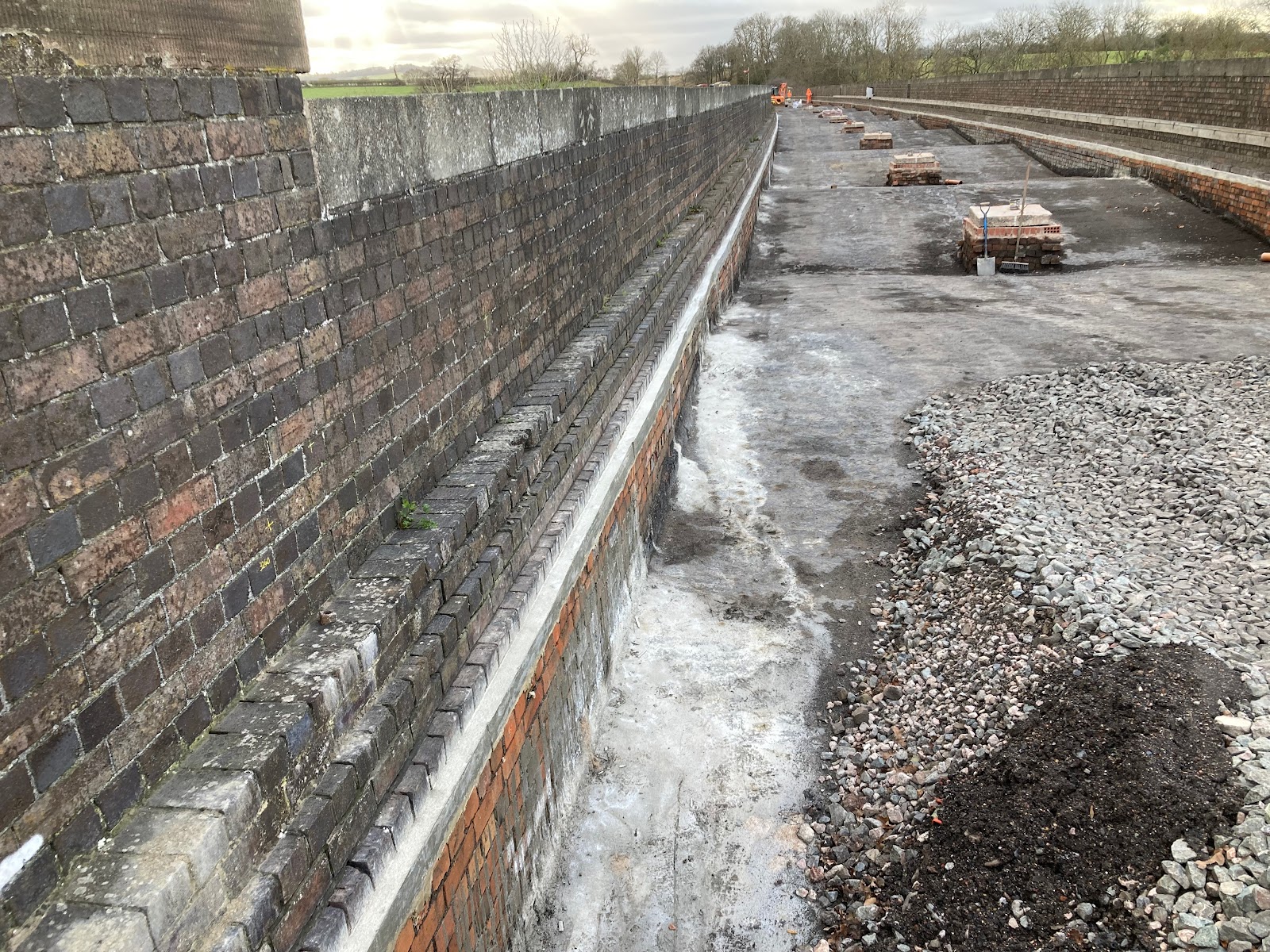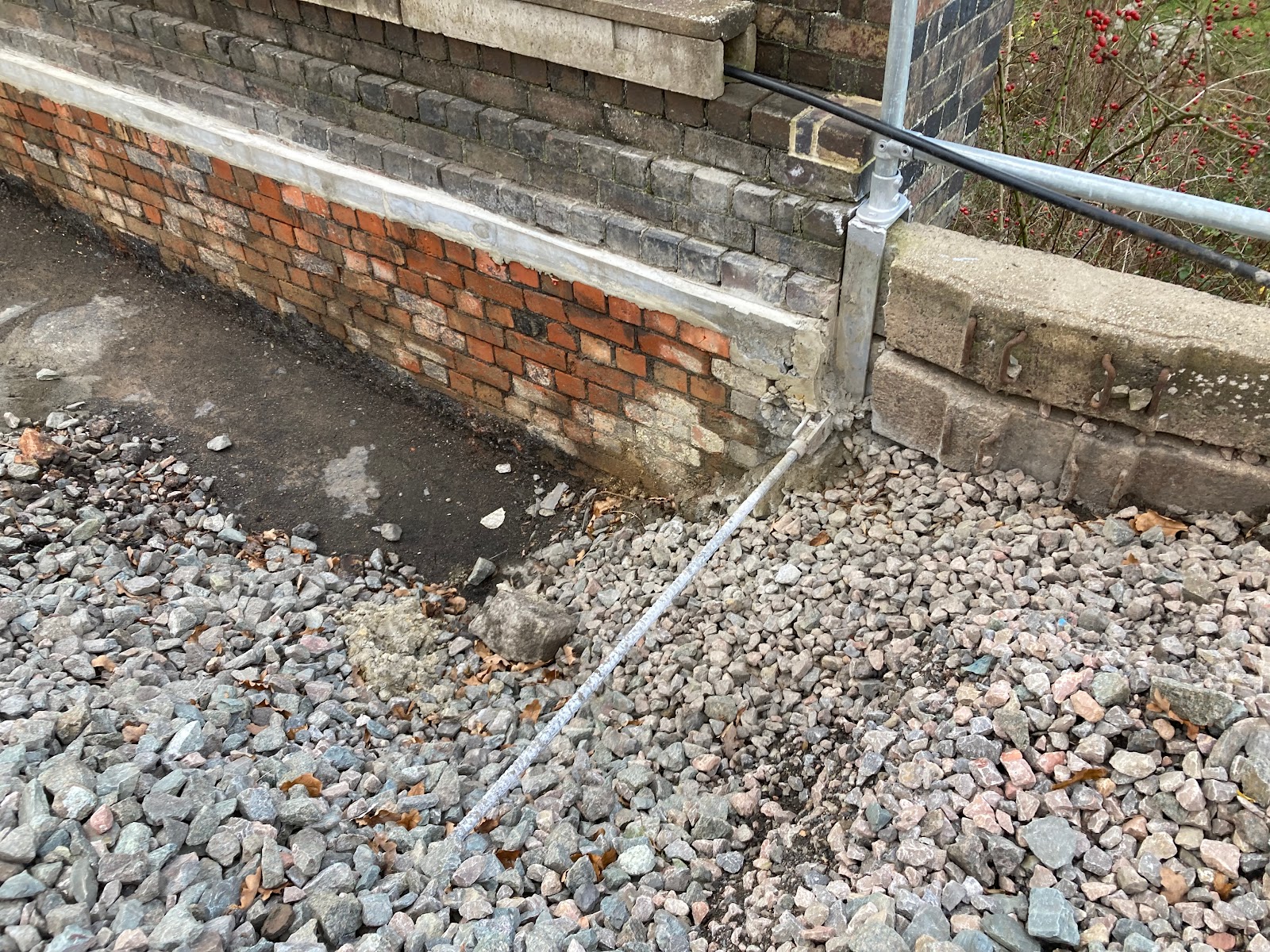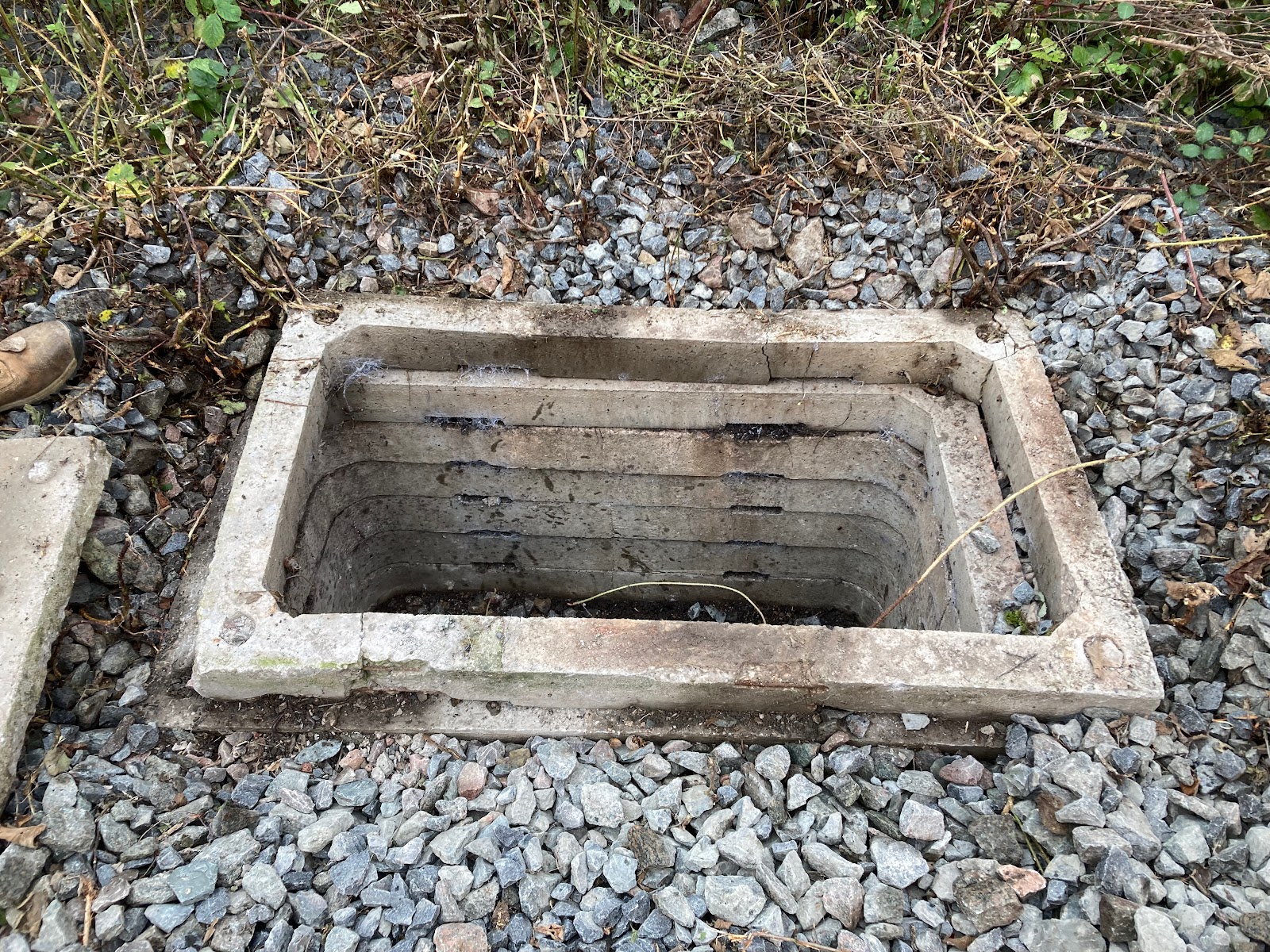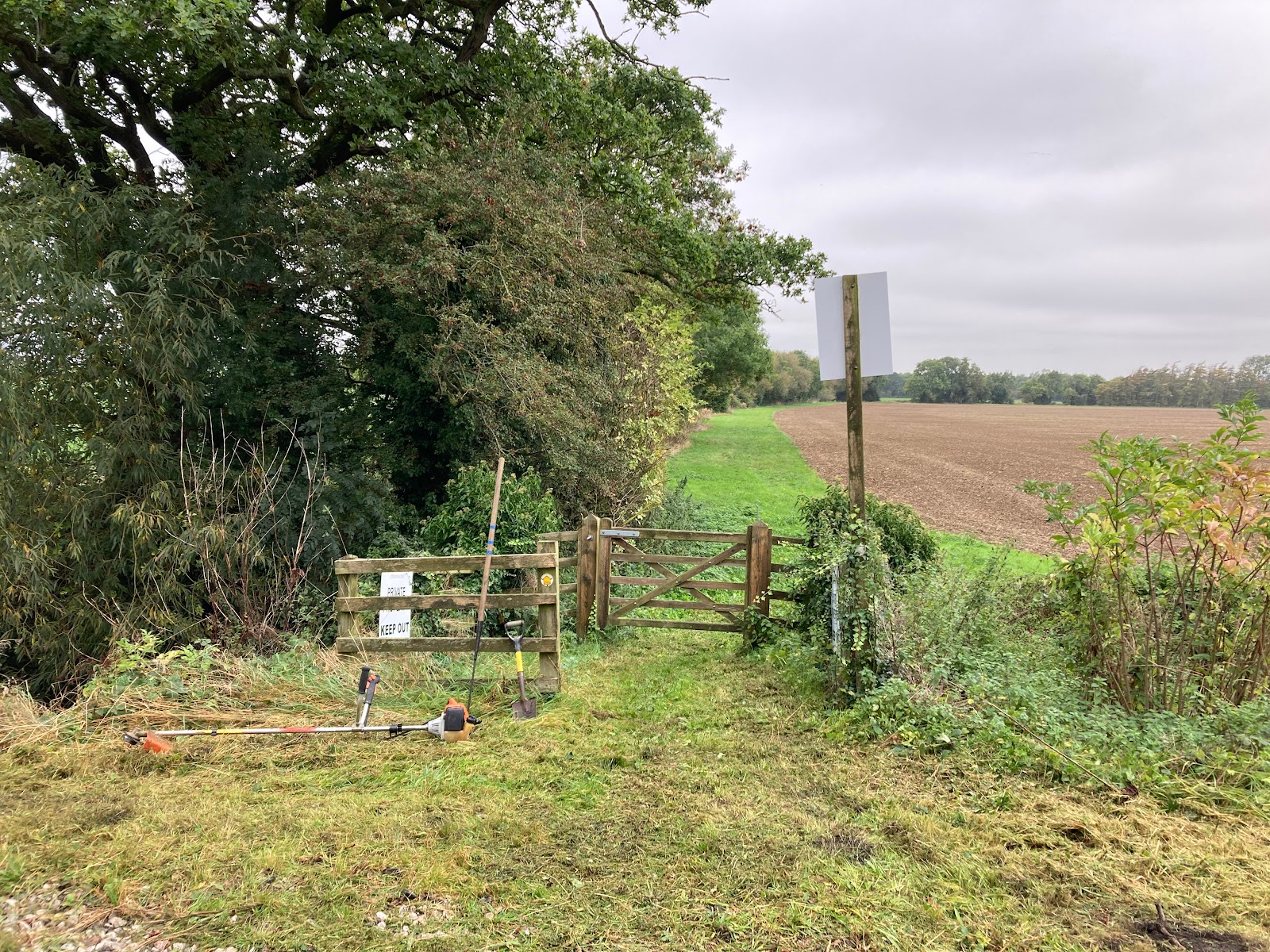As one year draws to a close and new one beckons, the current convention is for publications to publish a review of the year. So the next paragraph is our short review of 2023.
Wet.
Strictly not wet every day or even every working day. However, with the rainy and unsettled period in the summer (coinciding with the school holidays from mid July to end of August) and the early autumn storms, just wet seems an apt summary. Few people will remember the fine, sunny, warm spells which we did experience; particularly the mini-heatwave at the beginning of September.
One advantage of such wet spells is that we can see how well the railway’s drainage system is working, and where the bottle necks are.
I hope you have enjoyed reading our posts this year. Wishing you all Season’s Greetings and have a healthy, peaceful and prosperous 2024. And join me in asking Santa for more drier weather next year.
Thursday 16th November
Contrary to my introduction to this post, for the first time in a number of weeks we had a working day with no rain.
Roger, Martin. Stu and Ian were attending a brush cutter operative course provided by Greenway, all achieving the LANTRA qualification. The course also covered user maintenance, and as a result we are making some changes to our procedures. This should reduce the visits to a Stihl main dealer to once per year per machine.
Dave, Nigel, Jonathan and myself had a varied and productive day at a variety of sites on the railway. First of all was the raising of a crest chamber on the down side between Winchcombe and Greet tunnel. This had been hit by Tom Clark's robo flail. Four additional concrete rings were added - the vegetation will have to grow a lot to obscure it now. The other crest chambers towards the tunnel were checked - all will need raising, but only be one or two rings.
 |
| Raised crest chamber on down side between Winchcombe and Greet tunnel. |
Second item was to Stanway viaduct to collect some material that Walsh had surplus after constructing the set of steps on the low mileage end of the down side. This consisted of different lengths of galvanised tube and substantial timber boards; plus handrail fittings. These are now stored - they will be ideal for making some headwall safety handrails or makers.
 |
| Stairway to Heaven? No - the new steps to Stanway viaduct down side low mileage end. |
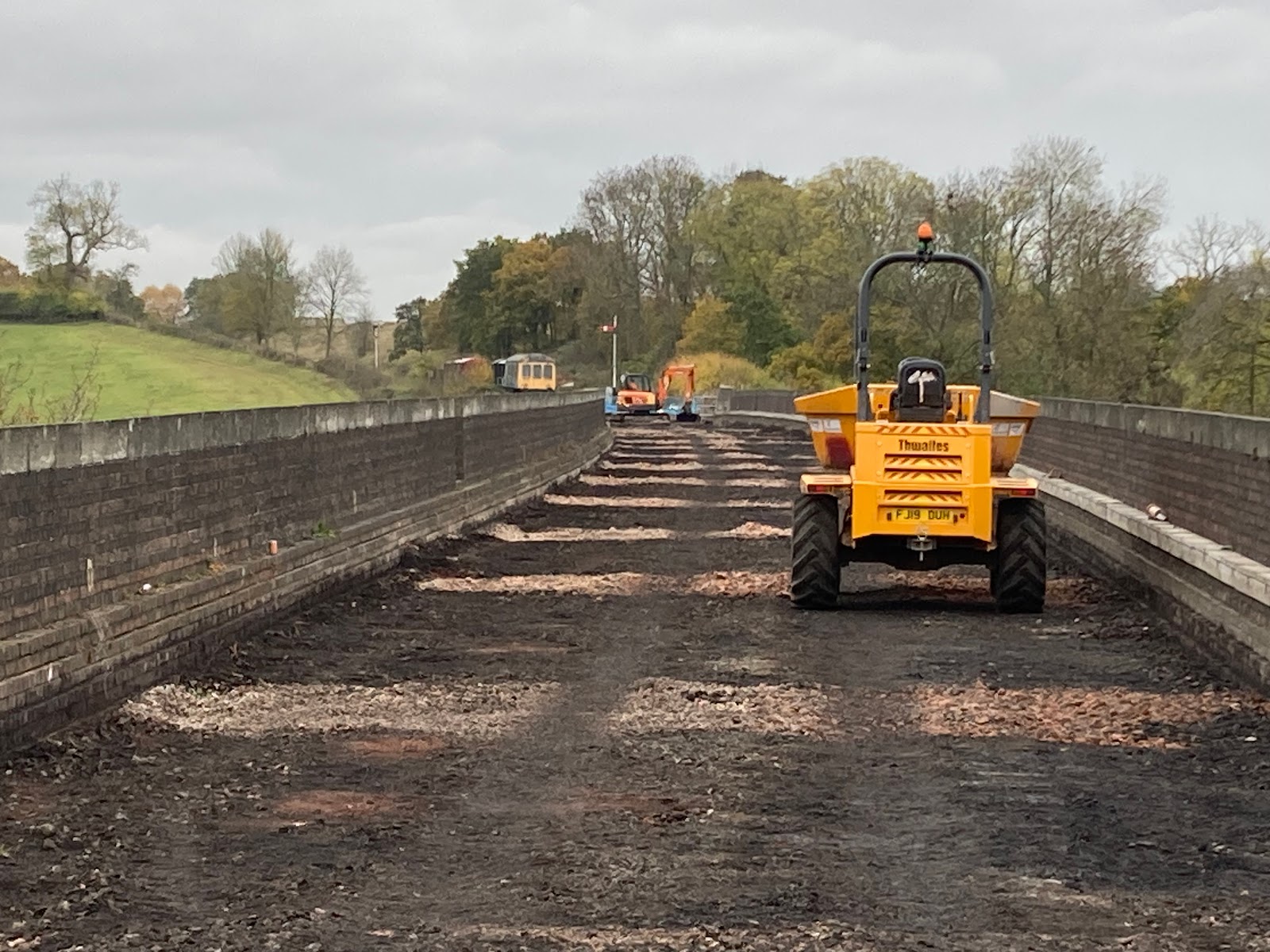 |
| Walsh's progress on the viaduct (as of 16 November); just after the extra work on the parapet was discovered. |
Third item was to continue with the culvert/cross drain internal visual inspections and clearance. Cross drains 25B and 25C which were cleared last week were inspected. Cross drain 27A and culvert 27B south of Gretton were cleared and inspected. On the later two there was significant vegetation growth on the down side alongside JJ Farms. Very apparent how much more water there is this autumn. This is making photographing the inside of the culvert bores difficult or impossible in some cases. Perhaps we need to invest in a selfi-stick! Photo of culvert 27B up side (below) was taken by reaching down from the headwall.
 |
| Looking into culvert 27B from the exit end (up side). |
On the way back from Gretton we stopped at Prescott Road bridge (32) for a quick inspection of culvert 31B. Following the work earlier this year on the exit to the roadside pipe/ditch this is flowing much better. Clearing the build up of debris on the grill to the roadside pipe and racking out some reeds from the pit increased the flow even more - essentially no standing water in the pit.
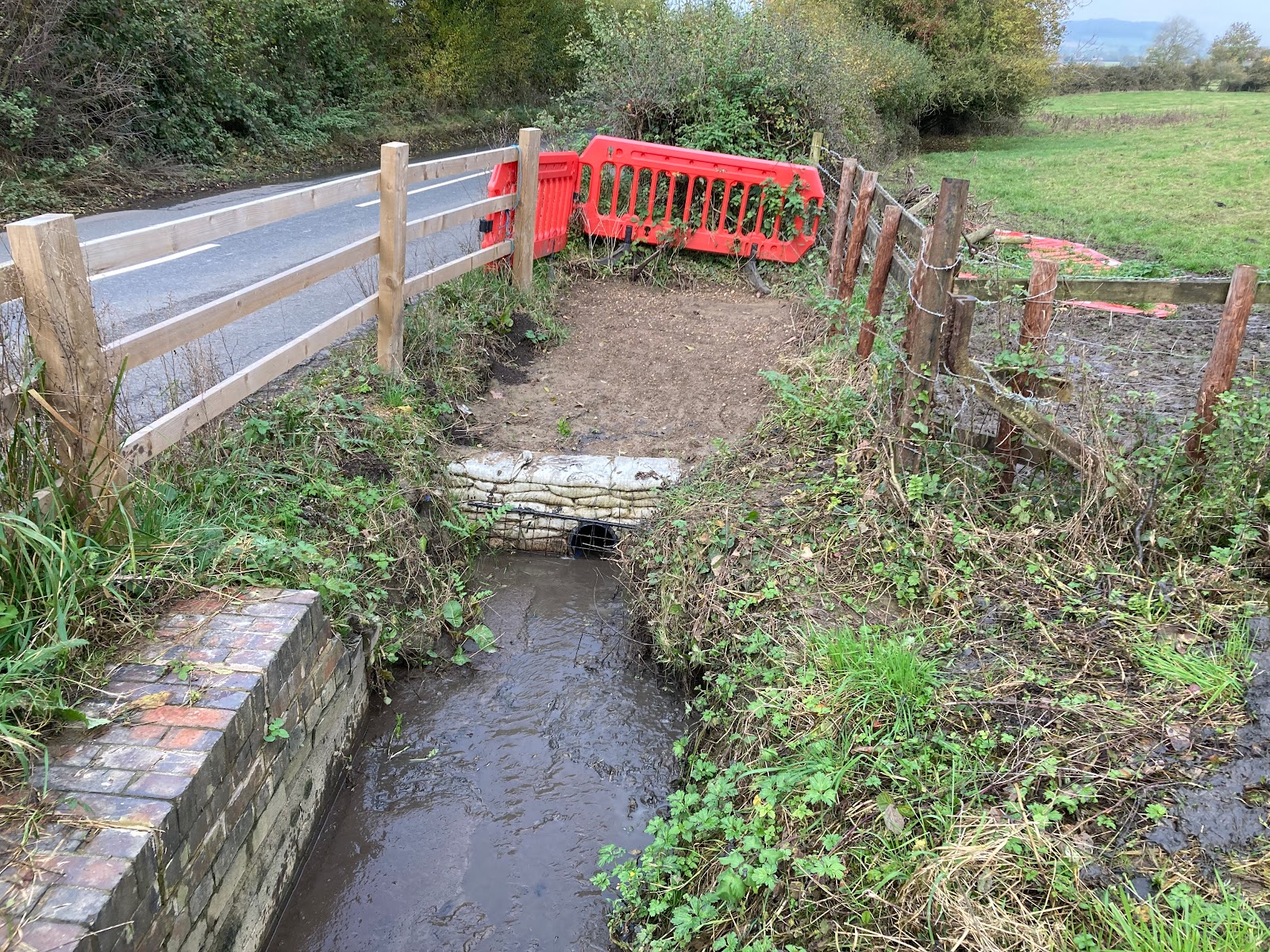 |
| Culvert 31B outlet, the entrance to the roadside pipe, Prescott Road. Just needs some replacement fence. |
Finally near the Tirle Brook culvert (32A) we found a cess chamber which also had had a close encounter with a robo flail (or was it the telehandler?) We reset the displaced top concrete ring. It will require a further visit to add another ring on top and to fish out the heavy thick lid which has fallen into the chamber. Despite these chamber hits, the robo flail provides some impressive results - picture below shows the cleared up side embankment at Working Lane.
 |
| Working Lane showing the cleared embankment on the up side low mileage end of bridge 25. Amazing what a robo flail can do! |
Wildlife report (all Gretton)
Rabbits - with quite a bit of
evidence of burrowing mainly on the down side cross drain 27A and
culvert 27B.
Kestrel.
Woodlice - underneath a toe ditch slab,
which was useful to show that this was just damp and not flooded.
Thursday 23rd November
Just a small team of four (Nigel, Martin, Dave and myself) working on drainage items - plus another two members of the team involved with the accident exercise (Jonathan as a casualty and Roger as first responder). At least this meant we could comfortably fit into one vehicle.
First item was to measure the ditch in Winchcombe Yard behind the site of the new S&T building. This is to get accurate estimate for quantity of concrete canvas to order; this to make the ditch water tight from the exit from Churchward House to beyond the new S&T building.
Then out to Gretton for the main tasks of the day; clearance and visual inspections of cross drains 27C, 28A, 30B and culvert 30A. The good news is that there is no obvious deterioration in these structures. What is obvious is the vegetation growth this year has been more than last year; and that all the water courses are flowing faster or deeper - apart from 28A inlet. (Picture below shows the small dribble entering the inlet chamber).
At cross drain 28A we removed a lot of sandy silt from the exit chamber (by the roadside entrance to the small holding). At culvert 30A we created a new access from track level to the boundary fence of the private road which runs under bridge 30. This is on the down side high mileage end. This embankment is steep here - there are sudden drops nearer the bridge and all four wing walls of the bridge are high and narrow and have no fences. The new access terminates at one of the headwalls of the down side toe drain that runs between cross drain 30B and culvert 30A. This would be a sensible site for a new set of steps such as that at Stanway Viaduct.
 |
| The new access route by bridge 30, down side high mileage. |
Then it was on to Prescott Road bridge to measure up for the replacement fence sections around the exit of culvert 31B.
Finally at Dixton cutting just on the low mileage side of the Tirle brook (culvert 32A) we recovered the thick heavy chamber lid from the cess chamber which the robo flail (or telehandler) had hit. We also raised the height of this chamber by one additional concrete ring.
 |
| Dixton cutting up side cess chamber - raised in height but still using the heavy (BR or even GWR era) thick lids. |
Wildlife report
Being a sunny day there was plenty of bird
activity. Raptors in particular, we spotted a red kite, a buzzard
being mobbed by crows, and a kestrel who appreciated the clearance of
30A improving visibility of small mammals from his perch on a dead
tree. There were lots of pheasants on the lineside (and in the four
foot) undisturbed by trains.
Thursday 30th November
Certainly the coldest day for a long time and almost a full turnout (8), the best for a couple of months.
First an unplanned job - to fix yet another cess chamber that had had a close encounter with either the robo flail or the telehander or one of the road vehicles. So Roger, Jonathan, Stuart and I headed to Chicken Curve where we found the chamber where the up side cess drains off to cross drain 20B at 11m35c. Two lids were broken; so as a temporary repair these were removed and a blue mesh grid placed on top weighed down with the one unbroken lid.
Meanwhile the other four (Ian, Dave, Nigel and Martin) had headed to JJ Farms Bridge to commence the internal inspections and clearance of cross drains and culverts for the day. First off was cross drain 31A. Then on to Prescott Road bridge where the other four arrived to tackle culvert 31B. Here the operation was recovering the sections of red barriers which were the temporary fence and to erect a new section of roadside fence and restore the railway boundary fence which runs over the new sandbag headwall of the roadside pipe. The roadside chamber on the inlet side (down side, low mileage) was cleared and inspected - significant amounts of Hydrogen Sulphite detected. The source of this was traced to foul water in the roadside ditch on the other side of the road (high mileage); this flows into a small pit together with the (dry) down side high mileage toe drain, then under the road to the chamber. Source of the foul water is outside of the railway boundary - we reported this to Severn Trent (which took some effort!).
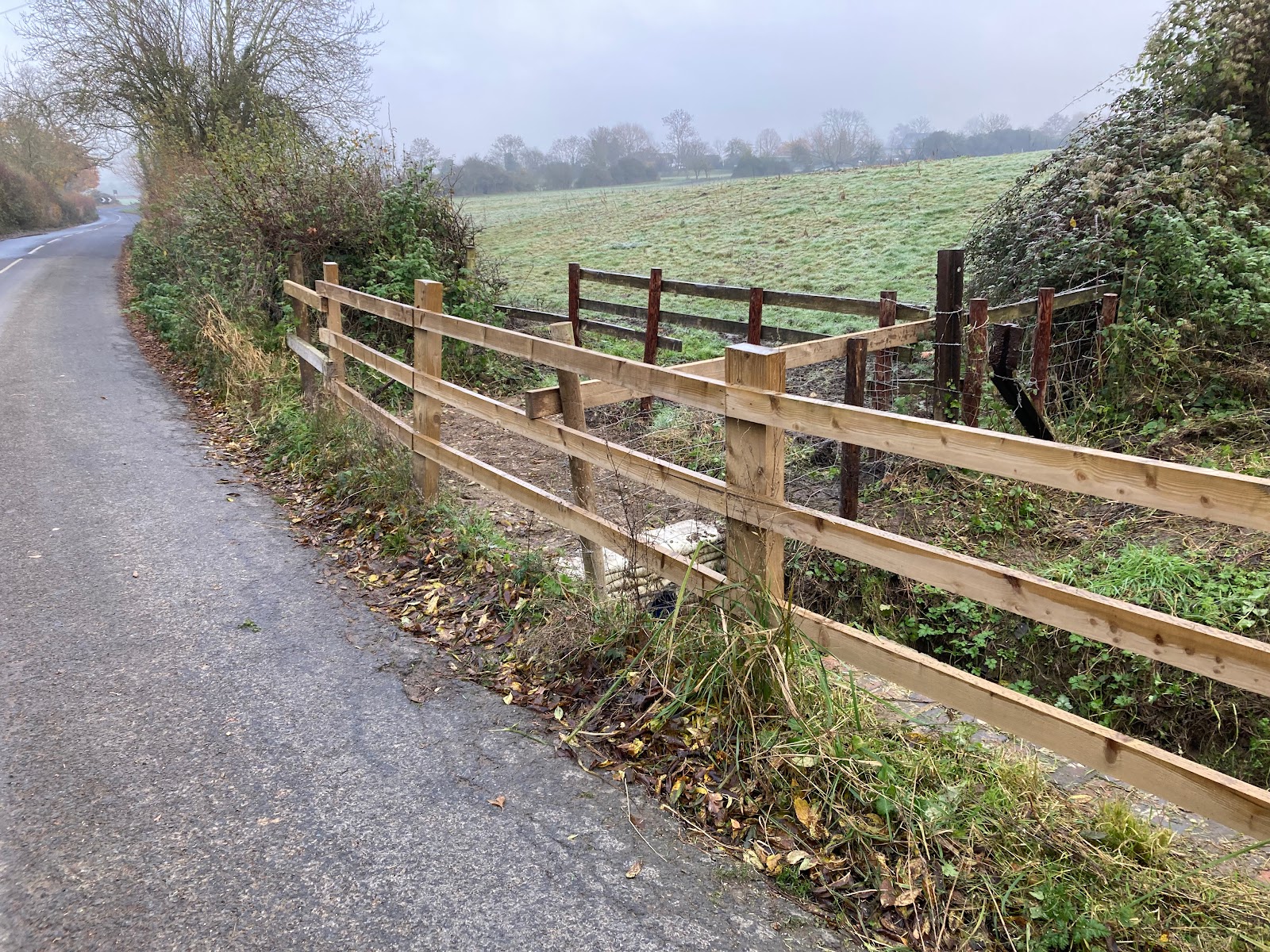 |
| All done at culvert 31B, Prescott Road, with the new sections of fence. |
Then on to culvert 32A, Tirle Brook flume culvert in Dixton Cutting and finally after a short lunch break cross drain 33A and culvert 33B at Gotherington Yard. All required significant vegetation removal, otherwise no apparent deterioration in condition. One exception is a chamber by the down side boundary fence on the toe pipe leading to culvert 33B. This needs a course of bricks replaced by a concrete ring or two and a new lid (or blue mesh). Also there is a small tree growing on the line of the pipe which needs needs removing - a job for our chain saw operatives, probably after Christmas.
 |
| Jonathan and Dave clearing out the inlet (up side) of Tirle Brook flume culvert 32A. Fortunately although the flow was fast, it was not deep. |
A lovely small and neat outlet headwall - and in good condition. Culvert 33B at Gotherington.
Thursday 7th December
Unlike last week, this week saw only a small team of five. So we did not split into groups. Additionally to avoid a soaking in the afternoon, we finished outdoor work at lunchtime. The afternoon was indeed one of the wettest this year.
First we headed to Stow Road Bridge (13) at Toddington to investigate raising the down side cess chamber. We cleared some of the silt that comes from under the side arch of the bridge during heavy rain. Then measured up for plan A, which is to add a concrete ring modified to pass the S&T cables underneath. The S&T cables run directly above the existing grill. Then with a metal or blue mesh cover; the chamber will be at the same height at the S&T trunking enabling additional ballast to create a better walkway as this is right by the uncoupling point for 7 coach trains. Unfortunately checking against a concrete ring has meant a move to plan B. The cutout to clear the S&T cables would completely wreck the integrity of the concrete ring.
 |
| Down side cess just by Stow Road bridge at Toddington showing the two issues. (1) S&T cables passing over the top of the grill. (2) Plenty of silt washed down the cutting side from the road above. |
Next was the continuance of the culvert/cross drain clearance and inspection programme. The first one this week was cross drain 14A - no need for clearance here as the Wednesday clearance team have done a splendid job all along the down side fence from Toddington Signal box. What we did need to do was to reset the top five concrete rings as these had become displaced and unstable. This was not an easy option with several inches of potentially foul water in the ditch. We applied our additional PPE and disinfectant procedures when dealing with potential foul water.
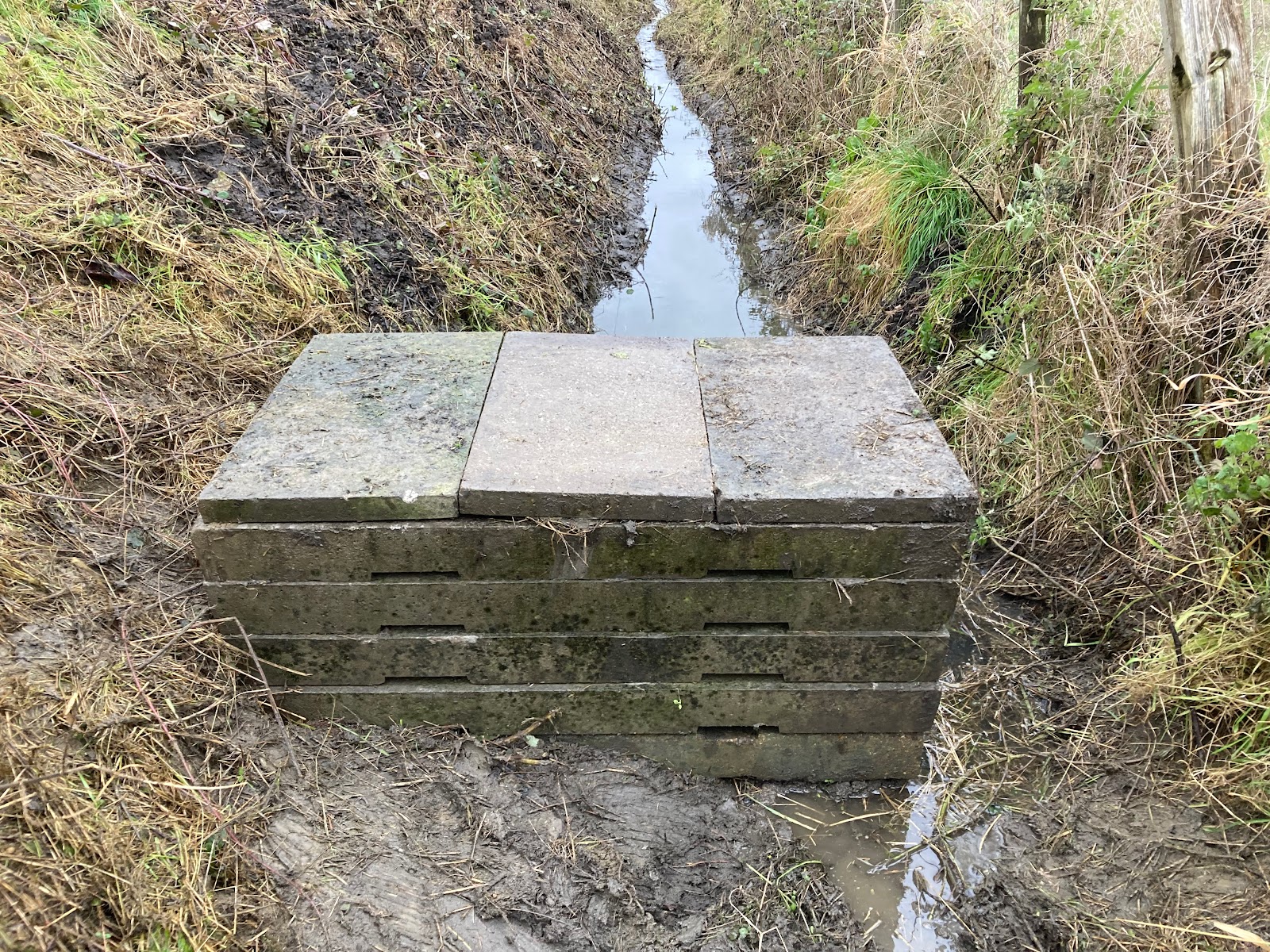 |
| Cross drain 14A, stack of rings on the inlet rebuilt. This is in the long ditch that runs all the way almost from Toddington Signal box to Didbrook No1 bridge. |
Then on to culvert 14B. Another good job by the Wednesday gang meant the down side access was already clear - so we just had the up side to clear. The up side exit pond here is currently very deep, we estimate at least 8 inches, and water is flowing fast out of the pipe under the adjoining land. Hence seeing what is happening on the high mileage wing wall was not possible. Finally onto culvert 15A - also flowing very fast. This will need a visit when the water has subsided to reset the concrete slabs on the low mileage side of the entrance channel.
 |
| Culvert 14B outlet - there is a small wing wall but the deep water makes inspection impossible! |
Finally just before the afternoon rains set in, we added two concrete rings to the up side cess chamber near cross drain 20B on Chicken Curve. This was one of those damaged by a vehicle (or the robo flail) - it now has a blue mesh lid so should be more visible. The wrecked concrete lids were recovered to the rubble pile in Winchcombe Yard.
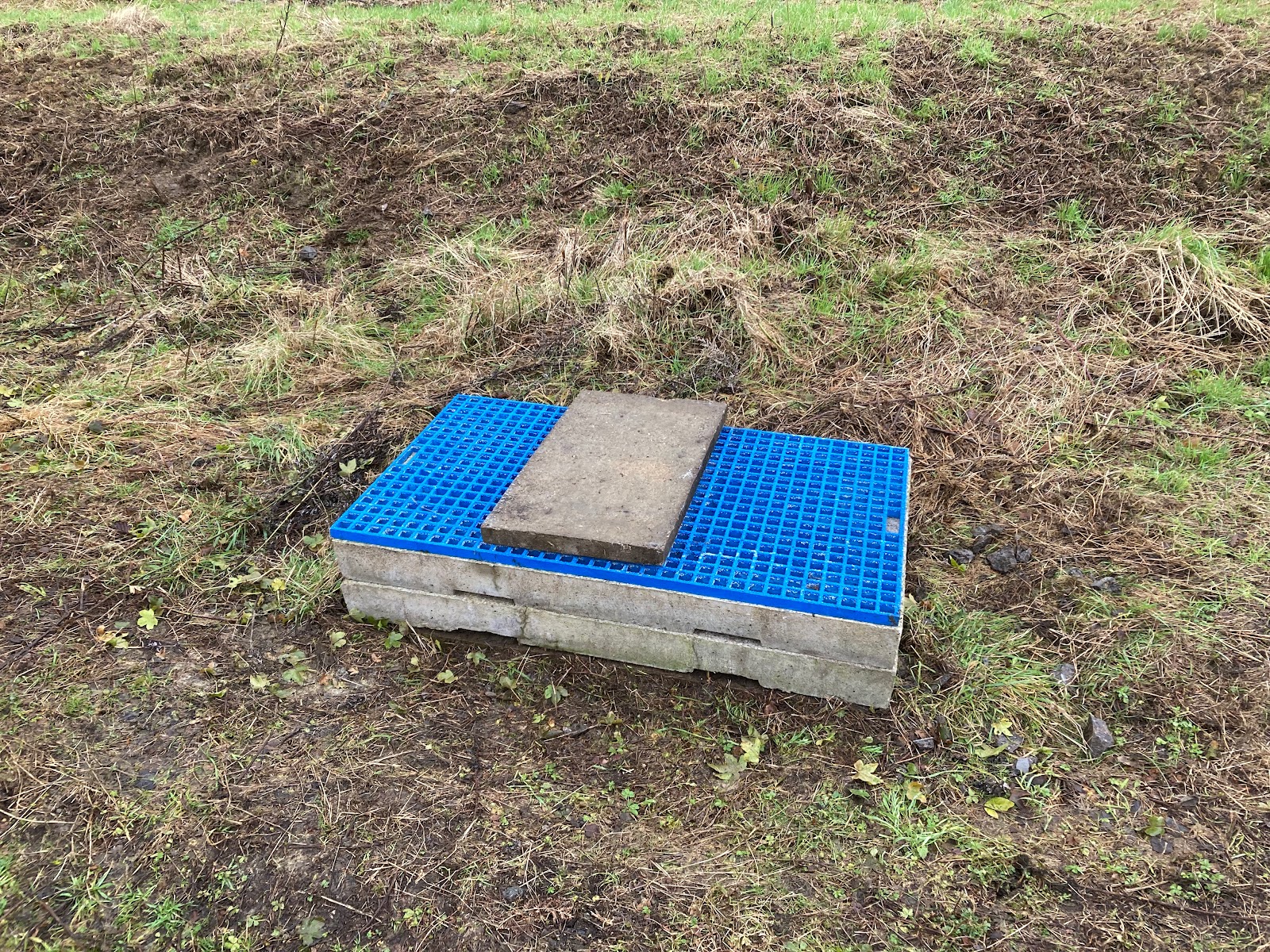 |
| Chicken Curve up side cess chamber fixed - raised and mess lid added. All fixed even before the defect report reached the team! |
In the afternoon in the comparative dry of the Estates Management container in Winchcombe Yard we spent some time performing preventive maintenance on some of the brush cutters. At this time of year, some of these machines get considerable usage on Thursdays and by the clearance teams on Saturdays and Wednesdays.
Wildlife report
Most wildlife was sensible not to venture out
in the rain. We did however get a very close look at a kestrel on the
power lines at Didbrook; and disturbed some pheasants on the up side.
Thursday 14th December
With seven team member attending and a dry (even sunny in the afternoon) day we achieved more than the work plan!
Culvert and cross drain visual inspections and clearance covered 16A, 16B, 16C, 18A, 19A, 19B, 20A, 20B and part of 20C. That is from Didbrook No 2 bridge (16) down to Chicken Curve. We also cleared the roadside gullies under Didbrook No 2 bridge - this is where some of the flow from the down side high mileage cess which does not go into 16A empties. During the rains over the previous weekend the road under the bridge had very deep puddles.
 |
| By the roadside on the down side high mileage of bridge 16 is where some of the cess drains flows out and into a roadside gulley. |
 |
| Plenty of blue paint on the lids of 16B outlet should make this more visible. |
Our clearance also covered all the cess chambers, mileposts and HP gas main markers on this section. In most cases this was the last few inches that our clearance contract’s robo flail can not reach.
A gulley drain in the farm track under Old Farmers Accommodation Bridge (20) also cleared - this reduced the standing water under the bridge.
Three of the team undertook a second inspection of the down side cess chamber intermediately under Stow Road bridge (13) at Toddington. This was in order to develop plan B, after determining that cutting slots into standard concrete chamber rings was not going to be feasible to raise the height the chamber without moving the S&T cables. Increasing the height with brick courses will need 120 bricks - and is a couple of days work. So perhaps we move to plan C – using GRP catch pit rings which are quicker to install and easier to cut the slots required for the S&T cables.
Wildlife report
Plenty of robins attracted by the cleared
access points to culverts/cross drains.
Large flock of birds
noted performing murmurations over towards Wood Stanway - but too far
away to determine if starlings or fieldfares.
Rabbits at Hayles
Abbey.
Voles at Didbrook.
Thursday 21st December
Another week with last minute reduction in the team strength to five. So we had to re-plan the work as the original idea was three groups. (A very valid excuse from our chief first responder, Roger, he had to cover a last minute gap in the first aid team for the Santa trains at Winchcombe.)
First task for the two early arrivals was to use the telehandler to extract the final stack of concrete catch pit rings from the items at the back of Winchcombe yard. This had to be accomplished early as the yard became full of parked Santa helper's cars by 9am. Six of the rings were then taken to the down side crest between Winchcombe Greet Road bridge and the low mileage portal of Greet tunnel. Five were used to raise the height of two crest chambers, the sixth was placed ready to be used when we construct a proper chamber on the end of the crest pipe. The opportunity was take to inspect the crest pipe - it was flowing well, it picks up two streams and some land drains. In the final crest chamber where some of the flow diverts down to the down side cess (and then runs through the cess drain in the 6 foot at the station) we removed a partial blockage of vegetation. We now only have three concrete rings left in stock - our intention is in future to use GRP rings as these are far easier to handle.
 |
| Martin, Nigel and Dave contemplate the options for building a chamber at the down side crest pipe entry close to the south portal of Greet Tunnel. |
On the way back from the crest we stopped to watch the first Santa train arrive at Winchombe. Normally we get a few waves from passengers - but with this train of excited children on the way to meet Santa we had a wave from every passenger. Maybe one or two of them will be the next generation of volunteers.
Two team members also ventured to Chicken Curve to complete the clearance and internal inspection of cross drain 20C. Water from the balancing pond in the down side orchard is trickling into the inlet here - the stream is running well. We discovered that there is a gap on the outlet (up) side inside of our fence so we could see that the flow in and out the bore is equal. Fortunate as looking into the bore from the down side shows there is something stuck in it. So we will have to return when the water level is down to attempt some rodding out. But this gives and excuse for our Christmas Quiz - what is it that is stuck in the bore? Picture below. We will reveal what the mystery object is when we extract it in the New Year.
 |
| What is that oblong shape partially obstructing cross drain 20C? Hopefully we will find out next year. |
 |
| The last Thursday before Christmas does mean we have service trains to watch. Foremarke Hall runs over Chicken Curve light engine to Winchcombe to take the second Santa ECS to Cheltenham. |
Then up to Stanton Aqueduct (bridge 9). The plan here was to seal the cracks in the down side concrete inlet and between it and the trough foundation with some flexible mastic sealant. However this does require the crack to be clean and dry - it was certainly not dry. Although the water from the stream is running in through the pipe and then right through the trough - there was signs of dampness in the cracks. Again, another task to reschedule for the New Year, with either a method to dry out the cracks or with some sealant which can go down wet. On the up exit side of the aqueduct we cleared the grill on the exit pipe into the adjoining field - this was well clogged with twigs and leaves.
Whilst at Stanton we took the opportunity to inspect the 11B to 11A up side diversion we constructed earlier this year. The real good news is that this is working well - there is very little standing water on the down side in the adjoining field; the low mileage inlet to the 11B bore was running slowly; flow in the new up side pipe was steady and increasing towards the exit into the 11A ditch. This suggests it is collecting water from the old land drains - good news for the toe of the embankment. Also good news is that there is no standing water at all on the up side, either on our side or our neighbours side of the hedge.
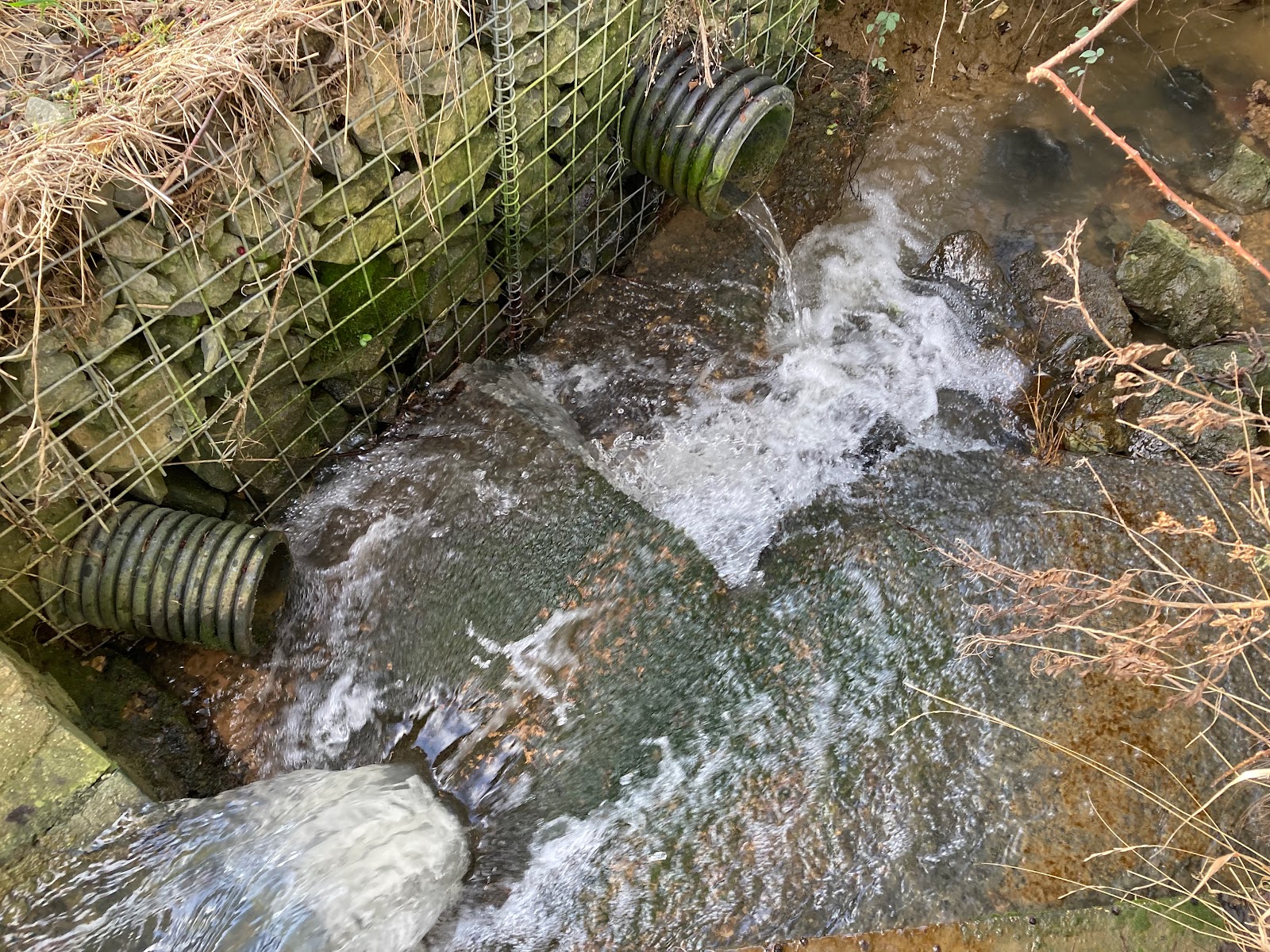 |
| The pipe at the top of the picture is the outflow of the 11B to 11A up side diversion - flowing well. The second pipe on the left is from under bridge 11, and the main flow at bottom is culvert 11A. |
As we were at Stanton, we took another peek at the work on Stanway Viaduct. The appeal for funding is still open, if you have not donated yet then please do so. Click this link. The additional work to secure the parapets has added to the cost of repairs.
| |
Wildlife report
Chicken curve: Herons
Stanton: Deer
(probably roe, not rein as none had red noses); Red kite, Buzzard,
Kestrel, crow, hibernating queen wasps (in discard child's jersey)
 |
| About the only time of the year when taking close up pictures of wasps is possible. |
Winchcombe station: Penguins (very tame and of a strange species which can sing in English!)








